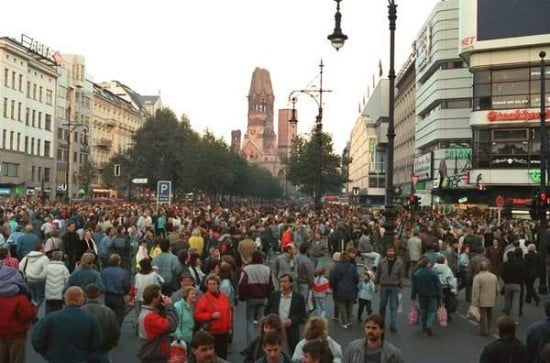Fall of the Berlin Wall as Seen From a Taxi
Wolf has been a taxi driver in Berlin for 32 years. On the evening of November 9, 1989 he was at work. On his car radio he listened to the famous speech by DDR politician Günter Schabowski, in which the latter announced the end of the Wall. As of immediately.
By Sanne Offringa, Guest Writer, Story Terrace
‘The fall of the Wall came as a complete surprise to everyone in Berlin. The people were so incredibly happy, the citizens of East as well as West Berlin. I had the feeling I was in a film, or dreaming.’
The result was a national feast day. Until then, people from East Berlin hadn’t been able to go to the Kurfürstendamm, Berlin’s famous shopping street, and now they were drawn to the place in one body. Wolf’s taxi was continually crammed with people on their way there. At one point, Wolf parked at the Kurfürstendamm and watched what was happening from the roof of his car. ‘There were so many people on the run, I imagined myself being in a big buzzing Chinese city. All the bars and restaurants, even five-star hotels, opened their doors and served free champagne to everybody. The crowd was euphoric; that day it didn’t matter what a bottle of bubbly should have cost.’
Marble Jeans
The Berlin Wall was erected to prevent streams of people fleeing from the communistic, poverty-stricken DDR East Berlin to the prosperous West. When Wolf came to West Berlin in the early eighties, the wall had been there for a while. He regularly visited friends in East Berlin, but to do so he had to go to one of the border crossings to buy a visa, valid until midnight, for 25 Deutsche Mark.
What immediately stood out in East Berlin were the clothes. East Berliners were walking around in stone-washed jeans made from such bad quality fabric that they turned white after three washes. That’s why they were nicknamed ‘marble jeans’. Moreover, clothing in East Berlin came in only a few colours and therefore almost everyone looked the same. Cotton was scarce and most people wore polyester clothes exclusively.
Wolf bought a typical East German polyester jacket once and he often wore it on his East Berlin trips. Did people there mistake him for a local? ‘No,’ he says, ‘most of the time they wouldn’t buy it. My accent always gave me away. Coming from Hannover, I spoke German without an accent, while people in East Germany had created a whole different dialect with their own unique words. For example, ‘chicken’ was referred to as ‘Broiler’ – a degeneration from English – instead of ‘Hähnchen’, the word we used in West Germany.’
Butter Mixed with Water
The contrast between east and west was enormous. In East Berlin everyone had a job, as determined by the communist regime, but even so there was extreme poverty. During the winter, stores didn’t sell any vegetables. Beer and schnapps, on the other hand, were in unlimited supply. They were used to curb people’s tempers. ‘East Berlin was broken in economic respects. When a baby was born, the parents would order a car right away for the child. That exemplifies how long waiting lists were, even for the most modest car.’
No Trees in East Berlin
Wolf still drives his taxi through his beloved Berlin every day, mostly transporting regular business clients. A great number of them he’s known for 10 to 15 years already. Born in Hannover, he’s always had a fascination for history. When he arrived in Berlin, 36 years ago, he fell in love with the place immediately. The rawness of the city, its history and even the Wall intrigued him immensely. 
When he drives people around today, he is regularly asked which part, exactly, was the former East Berlin. If you look carefully, this is clearly visible. ‘If you drive through modern-day Berlin, you can tell East from West. In East Berlin, there weren’t any trees. In West Berlin: a lot of them.’ The absence of trees has an unambiguous historical reason. ‘In 1949 the German winter was extremely cold. Temperatures dropped to minus 20 degrees Celsius. The Wall wasn’t there yet – they didn’t start building it until 1961 – but East Berlin had been ruled by the Soviet Union regime since the end of the Second World War. The Russians tore down every tree in East Berlin during that winter and used it as firewood.’
After the fall of the wall, the reconstruction of Berlin took many years. Even today, certain differences between former East and West Berlin are still visible. Wolf has loved his favourite city either way: with and without the Wall.
__________
 About the author: Sanne left her life as a lawyer behind to focus on her ambitions to be a writer. Now she successfully writes for a number of business clients and several Dutch magazines.
About the author: Sanne left her life as a lawyer behind to focus on her ambitions to be a writer. Now she successfully writes for a number of business clients and several Dutch magazines.
About us: Story Terrace helps customers to capture personal stories in beautiful books alongside a professional writer. Our writers have a range of backgrounds and interests, sharing one passion: Portraying individuals through carefully crafted anecdotes and lively stories.
For more information on having your stories written down, send an e-mail to info@ or get in touch via our contact form.
This month we celebrate that 25 years ago the Berlin Wall came down. Also read our article A Museum for Freedom about the Mauer Museum in Berlin. What’s your memory of this historical fact?




